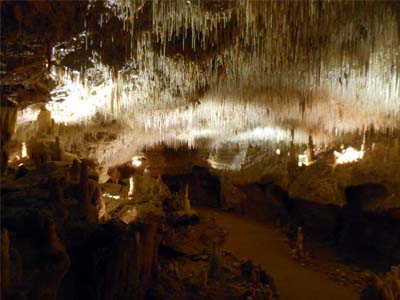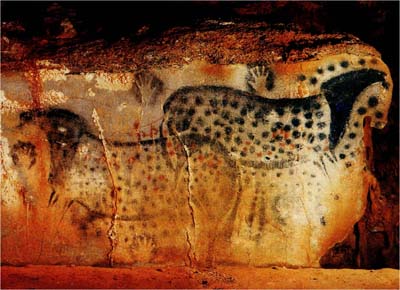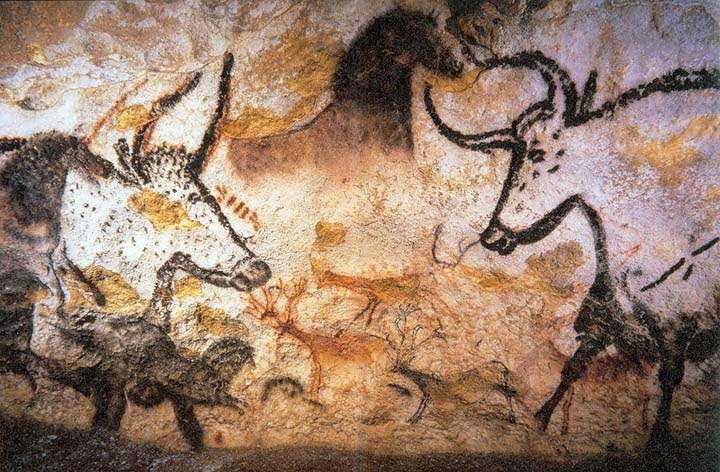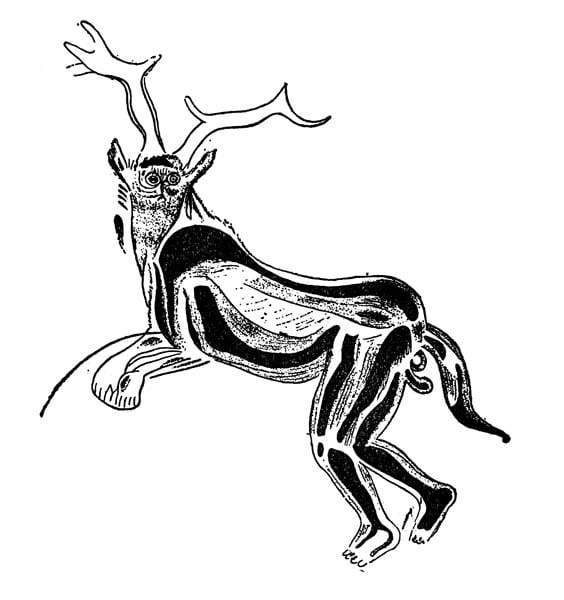The cave, womb of the Mother Goddess
Taken from: Anne Baring and Jules Cashford – THE MYTH OF THE GODDESS – The origins: the Paleolithic Mother Goddess – Venexia - October 2017
A little over a hundred years ago, no one suspected that there was human life when woolly mammoths grazed the frozen wastes that covered much of Europe and Asia. Then came the astonishing discoveries of Paleolithic caves in northern Spain and southwestern France: first Altamira (1879), then La Pasiega (1911), Le Trois Frères (1912), Tuc d'Audoubert (1914), Niaux, Les Combarelles, Pech-Merle (FIGURE 1) and Lascaux (1940), to mention only the best known. … The excavation at El Castillo in northern Spain, for example, shows that, prior to the Riss-Wurm interglacial period, in 186.000 B.C. About C., Neanderthal Man (Homo sapiens neanderthalensis), who preceded Modern Man (Homo sapiens sapiens), lived here. In the last century the discovery of more than one hundred decorated caves has upended previous theories of a uniquely warrior and hunter human being.
In the great caves of southwestern France, the story of a great primordial goddess is told through the art and rituals that took place inside. Paleolithic caves appear to have been the most sacred places, shrines to the Goddess, and the source of her regenerative power for at least 20.000 years (30.000 to 10.000 BC). Entering one of these caves is like taking a trip to another world, inside the body of the goddess. For those who lived in a sacred world, the shape of the empty cave symbolized the all-containing womb, which gives birth and welcomes back the dead. The cave as a place of metamorphosis was the obligatory link, between past and future, for the women and men who lived in its area closest to the entrance and held their rites in the depths of the inner sanctuary. …
Pets
The most surprising difference between the sensitivity of the Paleolithic and ours lies in the amazement and veneration that these primitive populations paid to animals. Early in the Judeo-Christian tradition humans are told to “fill the earth and subdue it: rule over the fish of the sea and over all birds and the sky and over all beasts that are upon the earth” (Genesis 1 :28). Such isolation from land and animals, birds and the marine world would have been sacrilegious in the Paleolithic, where animals were sacred, masters of the fundamental laws that dominated both the animal and human worlds. In cave art it is the animal that reigns supreme, exquisitely and carefully drawn, brilliantly colored and vividly alive. …
What was the nature of the bond between humans and animals that is so touching in this art? When the ice was at its maximum thickness and the land was a frozen tundra, only meat could provide sustenance, and for this reason the Paleolithic tribes had to hunt animals to survive; of these the furs and skins were also used, which provided warmth, protection and clothing. Their bones, tusks, horns and antlers gave material to transform into tools and on which to sculpt and paint sacred images; they supplied the tools to calculate the passage of time and the needles with which to sew their clothes. The bones, teeth and claws were made into necklaces, while the fat became lamp oil. Probably the animals were considered an embodiment of divine power, a gift of life to the tribe, and perhaps they were perceived as the generative power of the Goddess, which guaranteed them the continuity of life.
… In the sanctuary of Les Trois Frères there are 300 to 500 engravings of animals, superimposed on each other. There are 2000 engravings and drawings at Lascaux, some of which are 30.000 years old, although most date from the Magdalenian period (15.000-10.000 BC). …(FIGURE 2).
At Les Trois Frères is the astonishing engraving of a wounded bear. His body is covered in tiny circles as darts and shafts pierce his sides and blood oozes from his mouth. The depiction has often been considered part of a hunting ritual in which the bear is painted with the wounds hoped to ensure success of the hunt, an early example of magical wish-fulfilment. Sometimes a further concept is added: that painting was itself a propitiatory rite where one pacified the animal's anger, allowing the tribe to take its life without fear of punishment. The wholly non-religious explanation of these kinds of interpretations should alert us to their inadequacy. On the other hand, if the act of taking a life was seen as breaking a sacred order, the sacrificial depiction of the bear must have served two purposes: to prepare the tribe for the enormity of killing the animal and, at the same time, honorably ask the animal itself for permission to be killed. In the latter interpretation the painting is an ethical act that honors the bond between humans and animals and their connection to the whole, while in the first type of interpretation it is a mere survival expedient. …
The relationship between human hunter and hunted animal is quite complex and is reflected in the art of the Upper Paleolithic, where no human figure depicted with animals carries weapons with them, while many wear a sort of ceremonial dress, hold symbolic objects or are painted nude or covered with animal skins. …
Shamanism
…Through trance journeys, shamans and shamans visited a dimension inaccessible to the ordinary consciousness of the tribe, believing that the visible living world rested on the invisible one. Their purpose was to make an infinitely deeper sense of the human cycle of growth, bloom and decay. They could convey the awareness that the animal still lived in the oldest and deepest human memories, and from there channel its wisdom into the sacred rite. The Paleolithic people, living among animals, knew … that animals have superior powers. They could see and find their way in the dark. They knew how to recognize danger. They had immense strength, agility, miraculously perceptive eyes and ears. The shamanic gifts were similar to those of animals: they made them capable of "seeing in the dark", that is, further and more intensely than most of the tribe. …
High above the crowd of animals, at Les Trois Frères, emerges a large and impressive figure called the “Sorcerer” or the “Master of the Animals” (Figure 3)…
76 centimeters high and 38 wide, it is the only painting in the entire room to have been painted (in black), standing out against all the others. It may be the animal-shaman, placed there to teach the tribe about the animal world, and the source of the figure who became "Lord of the Wild Beasts." Only the feet that dance are decidedly human. The whole of the painting blurs the line between human and animal, leaving us in doubt whether it is an animal with human feet or a human dressed as an animal. He has the large, round eyes of a lion or an owl, the antlers and ears of a male deer, and the front two paws of a lion or bear raised up. He has the genitals of a feline and the tail of a horse or a wolf. The flowing "beard" resembles a mane and appears human only because of the arcane look of the eyes it frames. The most amazing thing about this magnificent god-like being is his expression, which seems to stare beyond our gaze, almost drawn to a mysterious dimension. Is it the ancestor animal, the soul of the tribe, or the incarnate image of our animal humanity? His feet are planted in the ground, allowing him to stand upright, one of the characteristics that distinguishes us from other animals. Though he appears to be dancing, his face is calm, as if asking us to enter into the meaning of his mystery – perhaps the paradox of being human and yet animal? …
Without art there would be no way to imagine the past. “The half-look thrown back, over the shoulder, at primitive terror”, which was once the general attitude towards our female and primitive ancestors, needs to be completely revised in the light of the magnificent paintings on the cave walls . Our view of history and any conception of a purely linear idea of the evolutionary course of human nature is therefore infinitely complicated by the discovery that Paleolithic men and women were extraordinarily fine artist(s) as well as "primitive" hunter-gatherers.
The artist and the shaman/s were probably the same person, as artists have always claimed. Through the magical power of recreating animals on cave walls, they connected the tribe with the source of life that animated humans and animals, becoming vehicles of that source, creators of life forms as their own source. … FIGURE 4.
Taken from: Anne Baring and Jules Cashford – THE MYTH OF THE GODDESS – The origins: the Paleolithic Mother Goddess – Venexia – October 2017






